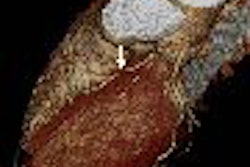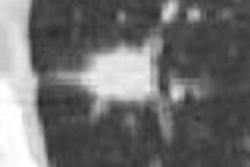More than 4 million people come to emergency rooms each year with acute chest pain, making it the most common symptom among ER patients.
With quick diagnosis and treatment of these patients paramount, Dr. Alexander Becker and colleagues from the University of Munich in Germany used multislice CT to find an effective method to achieve high diagnostic accuracy and reduce the number of nonevaluable examinations.
"We know that ECG testing has very high sensitivity for acute myocardial infarction, but it only possesses a reduced sensitivity and specificity for an underlying coronary artery disease in patients showing no signs of acute myocardial ischemia," Becker said in his presentation last month at the 2006 American Heart Association (AHA) conference in Chicago. "In patients with unstable angina, a stress test is not possible, so we long for a new imaging modality to help us in diagnosis."
Multislice CT is a useful diagnostic resource for the quantification of coronary calcification. "We know this has a high sensitivity for the detection of coronary artery disease, with a very high negative predictive value," Becker noted.
However, it also possesses a very low specificity and low positive predictive value, "meaning we will see many patients with coronary calcification showing no coronary artery disease in conventional angiography," he added. Noninvasive CT angiography (CTA) offers high sensitivity and high specificity, but is limited by coronary calcification.
Patient pool
The analysis evaluated 289 patients; all were over the age of 60, with a mean age of 62 years. All patients had experienced acute chest pain, had no signs of myocardial ischemia in their respective ECG tests, and were excluded if they had renal insufficiency.
In the study protocol, all patients underwent a scan on a Sensation 64 CT scanner (Siemens Medical Solutions, Malvern, PA) to determine a coronary calcification score. Patients then were divided into three groups. The first group scored zero in calcium scoring evaluation. Researchers assumed that this segment had no coronary artery disease and refrained from performing an additional CTA. The second group consisted of patients who scored between 1 and 400. Those patients received a diagnostic 64-slice CTA to verify the results of the calcium study. The third group included patients with a calcium score of more than 400. They also did not receive an additional CTA, since researchers expected a high prevalence of coronary artery disease in this segment.
Clinicians administered 80 mL of contrast agent and used a slice thickness of 0.4 mm. The protocol also used a retrospective ECG trigger to select CT slices with the best image quality. A follow-up CTA was performed the same day or one day later for stenosis evaluation. Stenoses of more than 50% were rated as significant.
The study found that 60 patients showed no coronary calcification at all. "In all of these patients, we could exclude coronary artery disease later in conventional angiography," Becker added. In the 1-400 calcium score range, 84 patients showed coronary artery disease, and in those patients with a score of more than 400, 82% showed coronary artery disease in conventional angiography.
"When we look at the diagnostic accuracy of the volume score alone, we find a very high negative predictive value of 100% in the group with the exclusional coronary artery disease," Becker said, "and we find a very high sensitivity of 100% in patients with scores above 400."
In the intermediate group with scores of 1-400, researchers found a reduced specificity of 76%, as was expected. "These results confirm our assumptions that it is this group of patients that will profit most from an additional CTA," he said.
Additional findings
In a further review of the results, the study was unable to examine 98 of 1,212 coronary segments. Eighteen segments could not be evaluated because of motion artifacts or inadequate opacification, and 62 segments were nonevaluable due to calcification. "When we look at the diagnostic accuracy of CTA, we could achieve a very high negative predictability of 99% and specificity of 98%," Becker said.
By combining the two modalities, sensitivity was 95%, specificity reached 94%, and diagnostic accuracy was 94%.
"What is especially important for our work in the emergency rooms, by performing these protocols, we could achieve a negative predictive value of 97%," Becker added.
One limitation of the study, he noted, is the high prevalence of coronary artery disease, which was 58%.
Still, Becker was very encouraged by the combination of coronary calcium scoring and CTA and its ability to offer the possibility of an effective and efficient diagnosis of coronary artery disease.
By Wayne Forrest
AuntMinnie.com staff writer
December 26, 2006
Related Reading
CTCA shows cost-effectiveness in the EU, November 27, 2006
Cardiac CT evolves on multiple fronts, November 20, 2006
CT coronary angiography identifies disease before valve surgery, November 16, 2006
CT assesses plaque composition, but with difficulty, September 18, 2006
Calcium CT scoring loss leader drives downstream benefit, August 3, 2006
Copyright © 2006 AuntMinnie.com




















